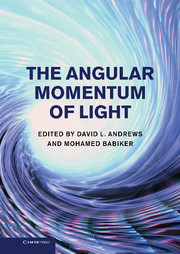Book contents
- Frontmatter
- Contents
- List of contributors
- Preface
- 1 Light beams carrying orbital angular momentum
- 2 Vortex transformations and vortex dynamics in optical fields
- 3 Vector beams in free space
- 4 Optical beams with orbital angular momentum in nonlinear media
- 5 Ray optics, wave optics and quantum mechanics
- 6 Quantum formulation of angle and orbital angular momentum
- 7 Dynamical rotational frequency shift
- 8 Spin-orbit interactions of light in isotropic media
- 9 Quantum electrodynamics, angular momentum and chirality
- 10 Trapping of charged particles by Bessel beams
- 11 Theory of atoms in twisted light
- 12 An experimentalist's introduction to orbital angular momentum for quantum optics
- 13 Measurement of light's orbital angular momentum
- 14 Efficient generation of optical twisters using helico-conical beams
- 15 Self-similar modes of coherent diffusion with orbital angular momentum
- 16 Quantum entanglement of orbital angular momentum
- Index
- References
6 - Quantum formulation of angle and orbital angular momentum
Published online by Cambridge University Press: 05 December 2012
- Frontmatter
- Contents
- List of contributors
- Preface
- 1 Light beams carrying orbital angular momentum
- 2 Vortex transformations and vortex dynamics in optical fields
- 3 Vector beams in free space
- 4 Optical beams with orbital angular momentum in nonlinear media
- 5 Ray optics, wave optics and quantum mechanics
- 6 Quantum formulation of angle and orbital angular momentum
- 7 Dynamical rotational frequency shift
- 8 Spin-orbit interactions of light in isotropic media
- 9 Quantum electrodynamics, angular momentum and chirality
- 10 Trapping of charged particles by Bessel beams
- 11 Theory of atoms in twisted light
- 12 An experimentalist's introduction to orbital angular momentum for quantum optics
- 13 Measurement of light's orbital angular momentum
- 14 Efficient generation of optical twisters using helico-conical beams
- 15 Self-similar modes of coherent diffusion with orbital angular momentum
- 16 Quantum entanglement of orbital angular momentum
- Index
- References
Summary
The quantum mechanical description of the azimuthal rotation angle and the orbital angular momentum around the polar axis differs greatly from the description of position and momentum. This has led to a controversy over the existence of a self-adjoint angle operator in the literature. It is possible to circumvent the problems of defining a self-adjoint operator for a periodic variable by using trigonometric functions of operators as a basis for the quantum mechanical description. This approach, however, does not allow us to study the properties of the angle operator itself. By using a state space of an arbitrarily large yet finite number of dimensions, it is possible to introduce angle and orbital angular momentum as a conjugate pair of variables both represented by Hermitian matrices. After physical and measurable quantities have been calculated in this state space the number of dimensions is allowed to tend to infinity in a limiting procedure.
The first part of this chapter reviews the difficulties associated with the quantum mechanical formulation of angle and orbital angular momentum and presents a way to overcome these problems using a finite-dimensional state space. In the second part this formulation is generalised to include the phenomenon of non-integer orbital angular momentum. This part is based on a chapter of the PhD thesis of Götte [1], where further details may be found.
Introduction
The correct description of a periodic variable such as a rotation angle or the optical phase has been a long standing problem in quantum mechanics. At the root of the problem is the question of whether the variable itself is restricted in a 2π radian range or whether it evolves continuously without bound.
- Type
- Chapter
- Information
- The Angular Momentum of Light , pp. 135 - 161Publisher: Cambridge University PressPrint publication year: 2012
References
- 2
- Cited by

